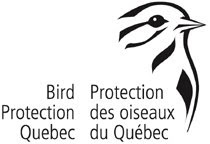Highlights of the morning included a nice group of 17 Hooded Mergansers with a dozen of them being displaying males strutting their stuff and trying to impress a group of mostly disinterested females. Wood ducks in full plumage are always a treat and didn't disappoint. A male Bufflehead seemed quite content to be shepherding his harem of six females around the waters off Verdun with not a rival in sight. And a lone Red-breasted Merganser fed in the shallows allowing a close look at the plumage differences between it and its more common cousins.
Several large flocks of waterfowl (200+ in total) were viewed flying downriver on the Cote Ste Catherine side of the water. Too small for Canada Geese and too large for ducks they appeared to be Brant but the distance and viewing conditions made a positive ID somewhat questionable. If anyone hears of any confirmed sightings of this species at that approximate time and location then our group would appreciate hearing from them. Of course that would mean admitting that there were other people of questionable mental capacity out birding in those conditions.
Thanks to Sheldon for co-leading and to Connie, Kathy and George for braving the elements to make for an enjoyable if soggy morning. - Wayne Grubert
Our complete list of 29 confirmed and one possible species includes:
Brant (possible) - 200 (see above), Canada Goose - 100, Wood Duck - 10, American Wigeon - 12, American Black Duck - 1, Mallard - 24, Greater/Lesser Scaup - 250 (Both species present), Bufflehead - 7, Hooded Merganser - 17, Common Merganser - 40, Red-breasted Merganser - 1, Pied-billed Grebe - 1, Double-crested Cormorant - 100, Great Blue Heron - 1, Red-tailed Hawk - 1, Ring-billed Gull - 50, Herring Gull - 1, Great Black-backed Gull - 3, Rock Pigeon - 6, Northern Flicker - 3, American Crow - 12, Black-capped Chickadee - 6, European Starling - 20, Yellow-rumped Warbler - 4, Song Sparrow - 5, White-throated Sparrow - 1, Dark-eyed Junco - 6, Red-winged Blackbird - 5, American Goldfinch - 2
Our complete list of 29 confirmed and one possible species includes:
Brant (possible) - 200 (see above), Canada Goose - 100, Wood Duck - 10, American Wigeon - 12, American Black Duck - 1, Mallard - 24, Greater/Lesser Scaup - 250 (Both species present), Bufflehead - 7, Hooded Merganser - 17, Common Merganser - 40, Red-breasted Merganser - 1, Pied-billed Grebe - 1, Double-crested Cormorant - 100, Great Blue Heron - 1, Red-tailed Hawk - 1, Ring-billed Gull - 50, Herring Gull - 1, Great Black-backed Gull - 3, Rock Pigeon - 6, Northern Flicker - 3, American Crow - 12, Black-capped Chickadee - 6, European Starling - 20, Yellow-rumped Warbler - 4, Song Sparrow - 5, White-throated Sparrow - 1, Dark-eyed Junco - 6, Red-winged Blackbird - 5, American Goldfinch - 2
Bernache cravant (possible) - 200, Bernache du Canada - 100, Canard branchu - 10, Canard d'Amérique - 12, Canard noir - 1, Canard colvert - 24, Grand Fuligule / Petit Fuligule - 250 (deux espèces présentes), Petit garrot - 7, Harle couronné - 17, Grand Harle - 40, Harle huppé - 1, Grèbe à bec bigarré - 1, Cormoran à aigrettes - 100, Grand héron - 1, Buse à queue rousse - 1, Goéland à bec cerclé - 50, Goéland argenté - 1, Goéland marin - 3, Pigeon biset - 6, Pic flaboyant - 3, Corneille d'Amérique - 12, Mésange à tête noire - 6, Étourneau sansonnet - 20, Paruline à croupion jaune - 4, Bruant chanteur - 5, Bruant à gorge blanche - 1, Junco ardoisé - 6, Carouge à épaulettes - 5, Chardonneret jaune - 2





No comments:
Post a Comment